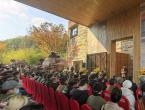The Transformation Beauty of Zhou Changgu's Character Paintings
2025-10-25 20:49:11 Xu Rushun
A young boy with a natural inclination to paint and doodle, and bold and bold in his actions, his lines dancing like dragons and phoenixes. If adults not only do not stop but also encourage him, it will further stimulate his desire to doodle. People will say that this child has a talent for painting. The child was appreciated and further depicted the illustrations in the book. With better conditions, he could still draw a copy of 'Mustard Seed Garden' and gradually, his paintings became more and more 'like'.
In order to create a "likeness", painters initially need to train their skills. We must work hard to walk the path that we will never know. 'Painting like' is the standard by which people judge painting, and a vivid sentence is the highest praise for the painter.
When the mountains are mountains, the water is water, the characters are people, the flowers and birds are flowers and birds, and all things in the world are revealed in the slightest detail, most people stop at this exquisite mountaintop and always play with their true abilities. Being able to paint such a picture, what you paint is what I see, and of course I understand and appreciate it greatly, which gives me a great sense of satisfaction.
But there are also restless people who, on the mountaintop that looks very similar, look around and are inspired by another instinct to break through the original rules. Can we draw it less like that? Can we generate some new atmosphere from this' likeness'?
This new atmosphere, because it wants to transcend the original 'likeness', is out of thin air and follows no rules. And we know that it is quite easy to draw 'existence' from 'existence'; Drawing 'existence' from 'nothingness' is too difficult. The success or failure of this transformation is the watershed that ultimately determines a painter's ultimate achievement, and it is the boundary between the painter and the master.
However, Zhou Changgu, who is familiar with the laws of Chinese and Western painting, is not satisfied with his existing "image". He wants to take a path that is not bound by form and transform into a new form of beauty. Moreover, in today's highly developed field of photography, painting has been replaced by high-definition color photos, which are difficult to meet people's aesthetic needs.
This process is like a silkworm baby, first binding itself in a cocoon, then accumulating strength, breaking out of the cocoon and transforming into a butterfly. The sublimation of beauty is truly even more difficult! In zoology, most pupae can break out of their shells, but as aesthetic painters, the vast majority can only bind themselves in cocoons, and very few can break out of their shells. Zhou Changgu is known as the most talented student by Pan Tianshou, and of course, he strives to break through the shell. He does have this ability and talent. French painting masters Matisse, Picasso, and Modigliani are all masters of figure painting transformation. Zhou Changgu is fond of them, but that is still an innovation of foreigners, which can only inspire and not be copied. His original mentor and dean Lin Fengmian's transformation of naked women and Peking Opera characters was also very exciting, but it was not allowed to be exhibited or published at that time. Anyway, he wants to find his own path, a path with Eastern aesthetics. But in that era, he was not allowed to go too far, and deviating from the norm would come at a high cost.
Driven by the passion for innovation, Zhou Changgu could only cautiously explore and take a small step forward. Since the 1970s, his teenage figure paintings have taken on a new look. People have found that some of his teenage girls' faces have increased the curvature of their lower cheeks (cheeks), exceeding the proportional relationship of "three stops and five eyes" on the character's face (facial proportion, vertical three stops, i.e. three equidistant distances: hairline to eyebrows, eyebrows to nose tip, nose tip to lower cheeks; horizontal five eye length). Some commentators believe that this was inspired by the face of his beloved little sister Zhou Suzi. Zhou Suzi's lower cheeks were particularly plump and abundant, known as the "Yizhe" in ancient times. Dean Pan Tianshou often inscribes "Yi" and "Yi Zhe" on his paintings because of his long chin. In the past, I couldn't understand what they meant.
The change in Zhou's figure paintings brought a surprising transformation to his paintings, breaking through the original precise "likeness" and giving rise to a new atmosphere. This can be seen from his series of masterpieces. Such as "Joyful Harvest of Fruits" (Zhou Changgu Calligraphy and Painting Collection, page 044), "Green Flower Branches in Spring Breeze" (045), "Poetic Picture of Li Bai" (054), "Story of West Lake" (059), "Joyful Harvest of Lotus Pond" (064), "Encounter" (065), "Summer Thoughts of a Girl" (069). And paintings such as "Where is Autumn" (093) and "Under the Hibiscus Flower" (098) on the side are examples of facial deformities of characters. There are many examples like this that can be given.
This transformation, he only took a small step, but it was precisely this small step that set him apart from several other "Zhejiang style figure painting" masters. They have taken a big step ahead of them in the modernity of painting. Placing his character paintings in the 21st century art world still doesn't feel outdated. Beauty keeps pace with the times and has strong modernity and vitality.
Zhou Changgu referred to this innovation as "enlightenment" and "independent creation". He had a sudden realization from his younger sister Zhou Suzi's chubby cheeks to creating a new style of character drawing, which was a great contribution to Chinese painting. He should have gone further on this road, but unfortunately he had too little time to paint. By the time he could paint as he pleased, he was already terminally ill. Before his death, he once told his beloved disciple Wu Yongliang (doctoral supervisor of the Chinese Painting Department at the Chinese Academy of Fine Arts), "I really don't want to die because there are still many things left to be done." This "unfinished business" should include exploration and practice of further transformation. He has just taken the first step, and he still needs to take the second and third steps to ultimately complete the entire transformation process and reach the pinnacle of his ideal.
He was a dancer in shackles in the 20th century, but unfortunately, God did not give him this opportunity.
Copyright Notice: Original content on this website is welcome to be reposted. Please indicate the source when reposting, Global Art Network www.caanets.com; Some of the content posted on this website comes from the internet. If there is any infringement, please contact this website to delete it.




